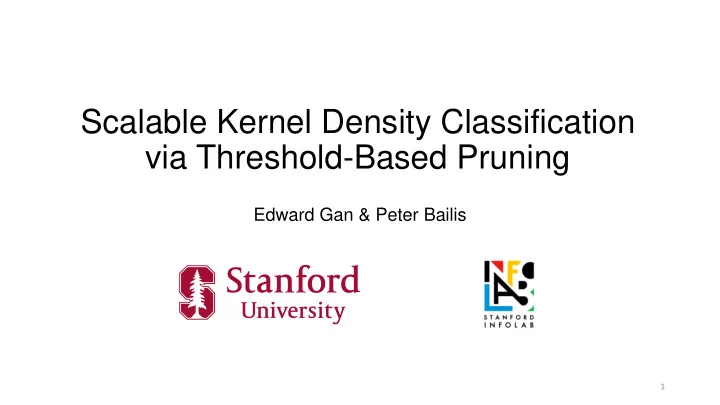

Scalable Kernel Density Classification via Threshold-Based Pruning Edward Gan & Peter Bailis 1
MacroBase: Analytics on Fast Streams • Increasing Streaming Data • Manufacturing, Sensors, Mobile • Multi-dimensional + Latent anomalies • Running in production • see CIDR17, SIGMOD17 • End-to-end operator cascades for: • Feature Transformation • Statistical Classification • Data Summarization 2
Example: Space Shuttle Sensors 8 Sensors Total End-Goal: Explain anomalous speed / flow measurements. “Fuel Flow” “Flight Speed” Speed Flow Status Problem: Model distribution of 28 27 Fpv Close speed / flow measurements. 34 43 High 52 30 Rad Flow 28 40 Rad Flow [UCI Repository] … … 3
Difficulties in Data Modelling Data Histogram Gaussian Model Poor Fit 4
Difficulties in Data Modelling Data Histogram Mixture of Gaussians Inaccurate: Gaps not captured 5
Kernel Density Estimation (KDE) Data Histogram Kernel Density Estimate Much better fit 6
KDE: Statistical Gold Standard • Guaranteed to converge to the underlying distribution • Provides normalized, true probability densities • Few assumptions about shape of distribution: inferred from data 7
KDE Usage Distribution of Bowhead Whales Galaxy Mass Distribution [L.T. Quackenbush et al, Arctic 2010] [Sloan Digital Sky Survey] 8
KDE Definition Kernels Each point in dataset contributes a kernel Kernel: localized Gaussian “bump” Kernels summed up to form estimate Mixture of N Gaussians: N is the dataset size Final Estimate Training Data 9
Problem: KDE does not scale 𝑃(𝑜) to compute single density 𝑔(𝑦) 𝑃(𝑜 2 ) to compute all densities in data 𝑦 2 hours to compute on 1M points on 2.9Ghz Core i5 How can we speed this up? Training Data 10
Strawman Optimization: Histograms Training Dataset Binned Counts Grid computation Benefit: Runtime depends on grid size rather than N Problem: Bin explosion in high dimensions [Wand, J. of Computational and Graphical Statics 1994] 11
Stepping Back: What users need Anomaly Explanation SELECT flight_mode FROM shuttle_sensors WHERE kde(flow,speed) < threshold Hypothesis Testing SELECT color FROM galaxies WHERE kde(x,y,z) < threshold 12
From Estimation to Classification SELECT flight_mode FROM shuttle_sensors WHERE kde(flow,speed) < Threshold KDE Model Classification Training Data 13
End to End Query Kernel Density Estimation Classification 𝑦 Threshold Filter Densities Training Data ቊHigh 𝑗𝑔 𝑔 𝑦 ≥ 𝑢 Low 𝑗𝑔 𝑔 𝑦 < 𝑢 Unnecessary for final output 14
End to End Query Kernel Density Estimation Classification Training Data 𝑦 Threshold Filter ቊHigh 𝑗𝑔 𝑔 𝑦 ≥ 𝑢 Low 𝑗𝑔 𝑔 𝑦 < 𝑢 15
Recap • KDE can model complex distributions • Problem: KDE scales quadratically with dataset size • Real Usage: KDE + Predicates = Kernel Density Classification • Idea: Apply Predicate Pushdown to KDE 16
tkdc Algorithm Overview 1. Pick a threshold 2. Repeat: Calculate bounds on point density 3. Stop when we can make a classification 17
Classifying the density based on bounds Upper Bound Upper Bound True Density 𝑔(𝑦) Classified Lower Bound Density Threshold Classified Lower Bound Threshold Pruning Rules 18
Iterative Refinement Hit Pruning Rule Upper Bound Threshold Density How to compute bounds? Lower Bound Algorithm Iterations 19
k-d tree Spatial Indices Divide N-dimensional space Nodes for each Region 1 axis at a time Track # of points + bounding box 20
Bounding the densities Given from k-d tree: Bounding Box, # Points Contained Total contribution from a region can be bounded 𝑔(𝑦) Total Contribution Maximum Contribution Minimum Contribution [Gray & Moore, ICDM 2003] 21
Iterative Refinement Initial Estimate Step 1 Step 2 Step 3 split 𝑔(𝑦) split split k-d tree root node Priority Queue : Split nodes with largest uncertainty first 22
tkdc Algorithm Overview 1. Pick a threshold • User-Specified • Automatically Inferred 2. Calculate bounds on a density • k-d tree bounding boxes 3. Refine the bounds until we can classify • Priority-queue guided region splitting 23
Automatic Threshold Selection • Probability Densities hard to work with: • Unpredictable • Huge range of magnitudes • Good Default: capture a set % of the data SELECT Quantile(kde(A,B), 1%) from shuttle_sensors • Bootstrapping Threshold Kernel Better Classification Estimate Threshold • Classification for computing thresholds • See paper for details 24
tkdc Complete Algorithm • Pick a threshold • Inferred given desired % level • Calculate bounds on a density • k-d tree bounding boxes • Refine the bounds until we can make classification • Priority-queue guided region splitting 25
Theorem: Expected Runtime 𝑜 number of training points 𝑒 dimensionality of data 100𝑁 ≈ 10,000 x 100 million data points, 2-dimensions 1 100𝑁 2 100𝑁 ≈ 10 x 100 million data points, 8-dimensions 7 100𝑁 8 26
Runtime in practice: Experimental Setup Single Threaded, In-memory Total Time = Training Time + Threshold Estimation + Classify All Threshold = 1% classification rate Baselines: • simple: naïve for loop over all points • kdtree: k-d tree approximate density estimation, no threshold • radial: iterates through points, pruning > certain radius 27
KDE Performance Improvement 5000x 1000x radial kdtree radial kdtree 28
Threshold Pruning Contribution 29
tkdc scales well with dataset size Our Algorithm: tkdc Asymptotic Speedup 30
Conclusion SELECT flight_mode FROM shuttle_sensors KDE: WHERE kde(flow, speed) < Threshold Powerful & Expensive Classification Training Data KDE Model Real Queries: MacroBase Systems Techniques: Predicate Pushdown, k-d tree indices: https://github.com/stanford-futuredata/tKDC 1000x, Asymptotic Speedups 31
Recommend
More recommend